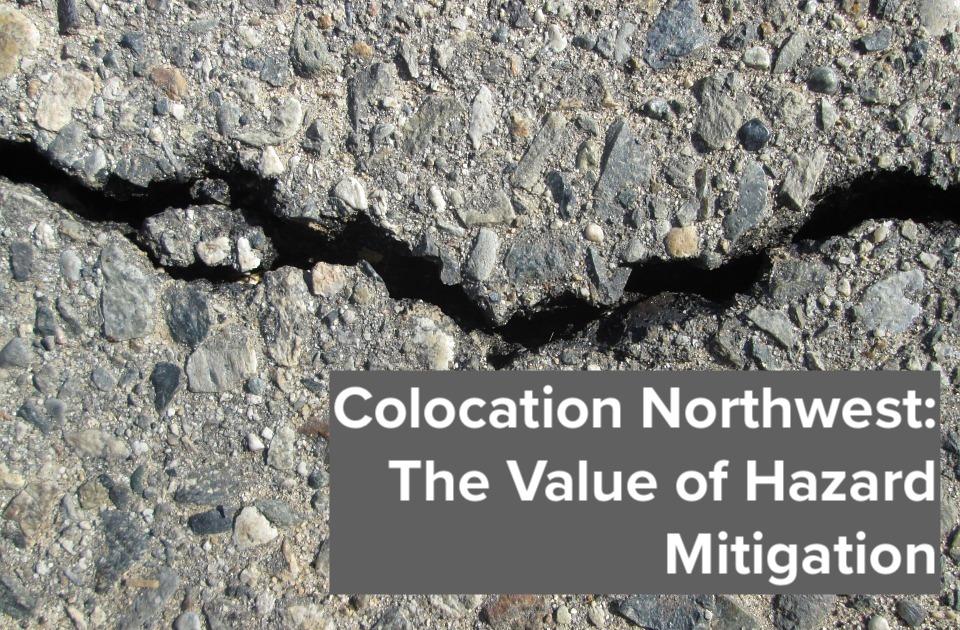By Luke Smith · 11/8/2018

Uptime is a key performance indicator at every data center. Mechanical failures, cyber-attacks, human error and natural disasters can all make data centers falter. Nature is particularly insidious. Lightning, ice, earthquakes, floods, hurricanes and tornados can all bring data center operations to a screeching halt. Each year costly natural disasters take their share of data centers offline. Fortunately, data centers and tenants can mitigate risks to keep everything running. Most solutions are either diverse or redundant.
Diverse hazard mitigation provides multiple routes for power, connectivity and cooling to enter a facility. For example, Colocation Northwest operates a dark fiber loop around Lake Washington. It connects Seattle, Redmond, Bellevue and Tacoma. If the cable is severed, anywhere, data continues to flow in the opposite direction. No one gets cut-off. Other ways to diversify include feeds from multiple substations or sending user data to remote backup storage.
Redundancy tends to focus on equipment inside a data center. For example, when the power goes out the uninterruptable power supply (UPS) takes over until the generators kick-in. Each step in the chain of backups can have its own redundancies: backup generators for backup generators or contracts with multiple diesel refueling companies in case one cannot deliver.
Carefully selecting your data center’s location, then building your facility to withstand the types of natural disasters known to threaten the site, is one of the best ways to mitigate risk. There are many ways to design a data center for its location. In areas known for tornadoes, build your data center to withstand winds up to 200 mph. Install multiple fiber and power connections, arriving from different directions and, if possible, sources, in case a storm damages the utility lines. In areas at risk for flooding or from hurricanes, select a faraway backup or failover data center to escape the widespread effects those types of natural disasters can inflict. No Houston data center failed during Hurricane Harvey in 2017 despite city-crippling flooding. Most data centers in the city are located in the northwestern suburbs, far inland and above the impact from storm floods.
Colocation Northwest’s South Hill Seattle data center is designed and constructed to meet the rigorous requirements of microchip manufacturers. Developers wanted a 40+ megawatt multi-tenant data center as impervious as possible to natural disasters. Seattle, a popular data center market, is exposed to many hazards. Like Houston, Seattle’s coastal location makes it prone to flooding. Engineers worry rising sea levels will eventually exacerbate water inundation beyond what city infrastructure can handle.
Downtown Seattle sits above a major fault, the Seattle Fault, while others crisscross Puget Sound. Earthquakes can trigger numerous damaging effects. They shake buildings and cause landslides. The ground can crack, rupture or liquify. Then, after a tremor stops, deadly tsunamis can swamp entire communities.
The South Hill Seattle grounds sit in a stable pocket, 20 miles from the nearest known fault. The structure exceeds seismic building code requirements by 25%, making it able to withstand a magnitude-9 Cascadia Zone subduction earthquake with little to no damage. The foundation sits on bedrock, which ensures that the ground beneath will not splinter or liquify during the strong tremors.
Liquification is a major risk to Western Washington data centers. During earthquakes ground particles separate while at the same time pressing down on the water table. This forces water up through the soil until it pushes against building foundations, causing severe damage. During the 2001 Nisqually quake, some data centers around Seattle filled with ground silt and were forced offline. When data centers are built on bedrock, the way South Hill Seattle is, the ground beneath cannot liquify.
Sitting at 528 ft above sea level puts South Hill Seattle high above the 500-year flood plain and far away from tsunami inundation zones. The data center is also outside of Mt. Rainier's lahar paths. Lahars are flash-rivers of ash, mud and fallen timber. They are natural disaster unique to mountainous volcanic regions.
Should Mt. Rainier erupt, Seattle's air currents typically drive eastward, which will push airborne ash away from the South Hill Seattle data center. Airborne ash is a major natural hazard risk that data centers in eastern Washington state will face.
Every market has natural disasters. With research and careful planning, data center operators and end users can find solutions that minimize risks. Multi-tenant data center providers who meet this challenge head-on can set themselves apart in a competitive market.